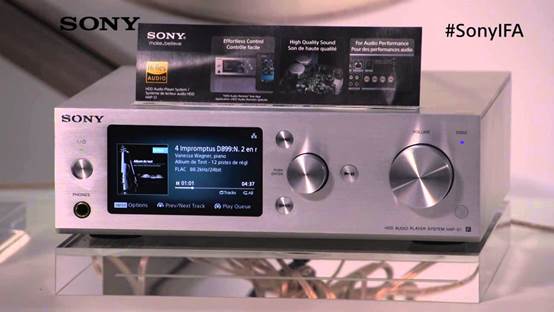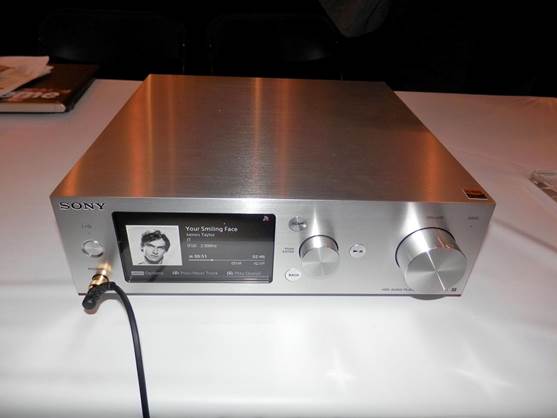The best I hear the HAP-S1 sounding is via
DSD. Miles Davis’ So What, from Kind of Blue, is a joy. There is a great sense
of space, a nice natural swing to the rhythms and a lovely lustre to the
trumpets. The Sony also manages to summon up a decent sense of the depth of the
recorded acoustic – which I know to be a very capacious thing. Instruments are
fairly well placed in the soundstage, although there’s never really a sense of
them being nailed to the furniture in your listening room. This is fair enough
though, considering the relatively low price of the unit, and all in all it is
a solid performer.

The
amplifier’s frequency response is very extended
Conclusion
Five years or so ago, the brave new world of computer
audio grew up into hi-fiseparates with hard-disk drives inside. Products from
companies like Brennan, Cambridge Audio and Yamaha offered instant playback of
computer files from standalone boxes. Then streamers appeared, and the whole
industry began to rally around this model. Sony’s HAP-S1 (and its bigger
HAP-Z1ES brother) are the first to elegantly combine the two technologies,
giving the best of both worlds. It works rather like a 21st century CD jukebox,
offering instant music, and plenty of it – but it seamlessly integrates with
your computer and its music library via your home network. In my view, this is
a brilliant solution.
The Sony HAP-S1 is a special product then,
offering an impressively easy and pleasant user experience, allied to excellent
build and finish, flexibility and decent sonics. At $1313 it’s not going to be
the greatest sounding system around, but is good at the price, and its rivals
can’t offer anywhere near the same functionality. Indeed, it’s quite an
audacious little product, showing a Sony Corporation back on the front foot.
Life has just got a little bit more interesting.
On Test
Sony rather carefully rates the amplifier
section of its HAP-S1 at 2x35W/4ohm, a performance achieved by the skin of its
transistors at 2x31W/8ohm and 2x38W/4ohm. There is some dynamic headroom
amounting to 38W, 60W, 46W and 26W into 8, 4, 2 and 1ohm loads, but this is
still no powerhouse and demands to be partnered with loudspeakers of moderately
high sensitivity. Distortion is low at bass frequencies (0.0035% at 100Hz), but
increases with frequency, reaching 0.012% at 1kHz and 0.18% at 20kHz (all at
10W/8ohm). Distortion from the digital/DAC stages ranges from 0.0025-0.05% at
0dBFs (20Hz-20kHz) to 0.0005-0.029% at –30dBFs over the same frequency range.

It’s
quite an audacious little product
The amplifier’s frequency response is very
extended with –0.5dB points at 3Hz-100kHz although the 0.11ohm output impedance
will introduce some variation depending on the impedance trend of the speaker.
Effectively superimposed on this, the ‘digital’ response peaks at +0.5dB/43kHz
(with 96kHz media) and +0.6dB/58kHz to –2dB/90kHz (with 192kHz media). Sony is
not using a fancy digital filter in the HAP-S1 as its impulse response shows
the familiar pre/post ringing. Digital jitter is usefully low at ~95psec for
all sample rates from 44.1-192kHz while the A-wtd S/N ratio is on a par with a
budget CD player at 104dB. The analogue amplifier’s S/N ratio is bang on the
industry ‘average’ at 85dB (re. 0dBW).
How it compare

Great
sense of space, nice natural swing to the rhythms and lovely lustre to the
trumpets...
The interesting thing about the Sony HAP-S1 is
that there are no direct rivals. There are one-box systems like the Brennan JB7
500GB ($804), which is a non-networkequipped HDD jukebox with amp, or the likes
of the Sonos CONNECT:AMP ($656), which is an amplifier and network music
player. Alternatively there’s the Arcam Solo Mini ($1260), which is neither of
these, but offers real hi-fi sound. The Sony does much of this and more –
adding true hi-res 24/192 PCM and DSD (5.6) support – as well as its clever
hybrid of hard disk and networked operation. It sounds better than the first
two rivals, but doesn’t match the openness and insight of the Arcam. Then
again, the Arcam doesn’t have hi-res or a built-in hard drive like the Sony.
|
Details
·
Product: Sony HAP-S1
·
Origin: Japan/China
·
Type: one-box system
·
Weight: 5.8kg
·
Dimensions: (w x h x d) 265 x 88 x 304mm
·
500gb hard-disk drive (expandable via USB)
·
DSDIFF(DSD), DSF, MP3, WAV, WMA, AAC, FLAC, ALAC, ATRAC, AIFF
support
·
Quoted power: 40W RMS per channel (4ohm)
·
Headphone output
Verdict
·
Sound quality: 4.5/5
·
Value for money: 5/5
·
Build quality: 5/5
·
Features: 5/5
·
Overall: 5/5
·
Like: HDD storage; software integration; versatility; build and
finish
·
Dislike: No HDD recording; no USB digital input
·
We say: Lovely little hi-res playing package; easy to use and
fine sounding
|